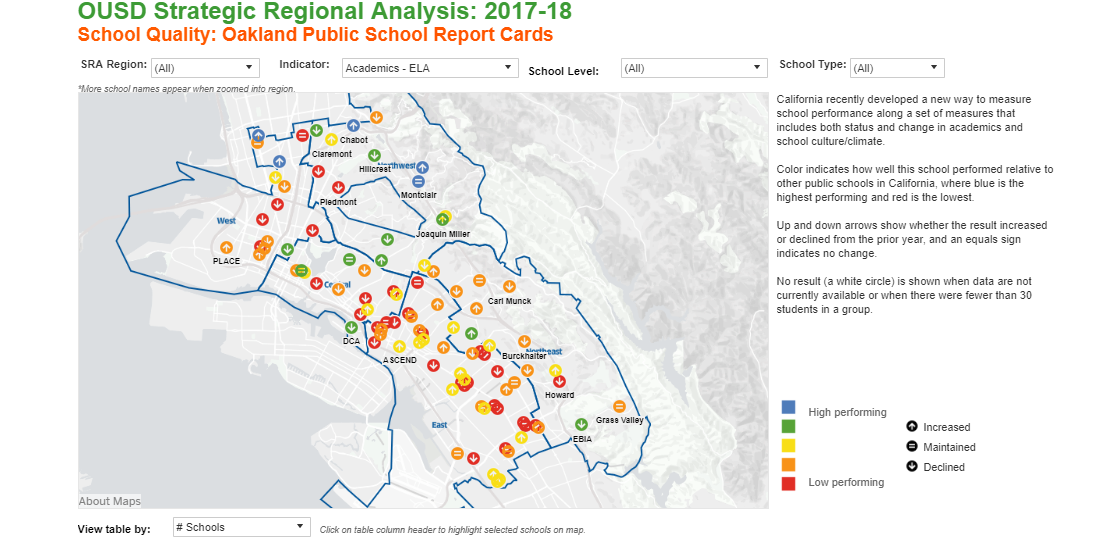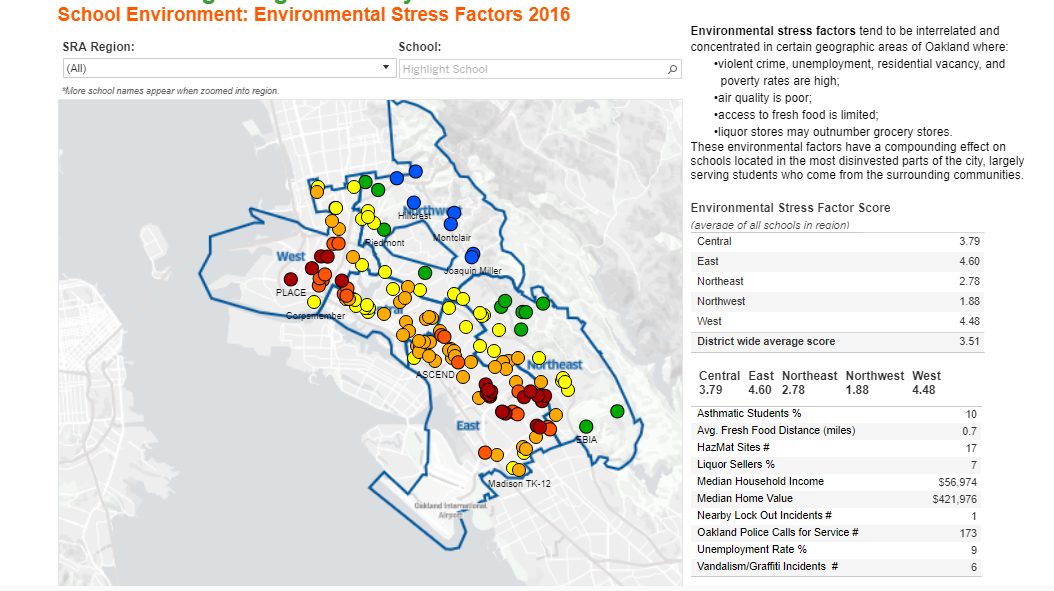“An African-American born in West Oakland can expect to die almost 15 years earlier than a White person born in the Hills” –Alameda County Public Health Department Report
Some neighborhoods in Oakland provide ample opportunities, safe parks, high achieving schools, clean air, and a wealth of opportunities. Other neighborhoods don’t. And it is not a coincidence, who lives where, who benefits, and who suffers. These are the ghosts of legal segregation, and they continue to haunt us, and will until we exorcise them.
The recently passed, “Opportunity Ticket” is one such answer. But we need to keep fighting for more, so let’s look at the issue of access to quality schools, who has access, who doesn’t, why, and what we can do.
An Unnatural State of Segregation
Segregation in Oakland was created under the Color of Law. Take a look at the “redlining” map (below), areas where banks would not provide loans. Places where Black folks were concentrated, where you had to rent and subdivide units, and housing was more costly and lower quality, because there were not other areas where Blacks could live. So it is crowded and polluted, and the city invests less in sewers, schools, transportation, public safety, and everything else.
Now you have a ghetto.
More health risks, less social services, lower quality schools, less wealth, less access to opportunity, and the stigma that goes along with it. One West Oakland school has 39 nearby Hazmat sights.
A large part of this was government action around housing and the ability to get a loan to own a home, as Richard Rothstein puts it,
The HOLC (Home Owners’ Loan Corporation- who first opened the door to middle class home ownership by providing loans in “safe” neighborhoods) created color coded maps of every metropolitan area in the nation, with the safest neighborhoods colored green and the riskiest colored red. A neighborhood earned a red color if African Americans lived in it even if it was a solid middle class neighborhood of single family homes…
And later when the FHA insured loans it’s “appraisal standards included a whites only requirement”
In thousands of communities from Fanwood to Berkeley FHA policy was the same, with very few exceptions: no guarantees for mortgages to African Americans or to whites who may lease to African Americans, regardless of the applicants’ creditworthiness” p 67
I am not even going to get into how urban redevelopment subsidized transportation for White suburban residents at the expense of Blacks in West Oakland, or the GI loans that bought homes for White soldiers and denied them to Blacks. Nor am I looking at the adverse health effects of diesel trucks driving through the West, the industrial uses next door to housing, or the obscene rates of asthma and ER visits, not to mention the decreased life expectancy.
Mapping Inequality
Let’s just look at the redlining map, the school quality map, and the environmental stress map (You can click the images for a better view)
What do you notice? Pretty similar patterns around redlined housing, neighborhood stress, and school quality.
No “Orientals, Asiatics, or Africans” need apply
There is nothing natural about our neighborhoods, they were designed to be exclusive. Here’s an excerpt from the property flyer for my neighborhood (sewage, transportation and no undesirables).
- That Maxwell Park is the only new addition to be put on the market this year that will have all the improvements in ready to build.
- That the water mains are now in to every lot.
- That the street car line will be extended at once to the intersection of Fleming and Madera Avenues.
- That the property is restricted as to Orientals, Asiatics and Africans.
Assigning schools on the basis of historic neighborhoods perpetuates exclusion. By choosing to link school options to housing, we are replicating this broken and immoral system. And we have an obligation to history and the future to change.
How Enrollment Rules Undermine Equity
District and charter school enrollment rules conspire against equity from top to bottom. Even those most “fair” mechanisms like lotteries. Redistributing opportunities and privilege means upending these rules, something Oakland Unified has started, and gotten huge pushback on. But it’s time we take a hard look and make some hard choices. I agree with Trustee Harris’s comments at an OUSD meeting that for too long Black students have been “locked out” of Oakland opportunities, and it’s time we change that.
So let’s look at how enrollment happens. First you enroll in your district of residence. As Ed Build noted, many district boundaries create gates of privilege—look at Oakland, within Oakland is Piedmont—its own district, those kids get 5k more than kids across the street in OUSD, and 2% of those students are poor. So if you can afford to live in one district yards away from another you get a lot more.
Then look at neighborhood boundaries, most of OUSD’s top scoring schools are in neighborhoods with average home values in the million dollar range, so if you can’t afford to live there, you don’t get those schools. And going to an out of neighborhood school, you can really only access those if you have transportation, which again privileges some and disadvantages others. Take look at the map of school performance—you have very different odds of attending a green school based on where you live. Within the same district we have schools where most students are disadvantaged and not a single student reads on grade level and others with minimal disadvantage and high likelihood of grade level reading.
The heart of the matter
The big issue is the supply of high quality schools and who gets access to them. We don’t have enough high quality seats to meet the demand for them, so the question becomes who gets them. Right now, the system privileges the more privileged. This should not be a surprise, despite frequent equity talk, very few have ever walked the walk. And even fewer will give up their privilege.
But the state created this mess and the state and well meaning people have a duty to do something.
There are small changes we can make; reserving seats for newcomers or latecomers, giving preferences for diverse students, or those in “merging” schools, providing greater transportation, or doing away with ranked waitlists and just doing a lottery for openings—without regard to when someone applies. There are probably other great ideas out there. The issue is ultimately one of will though, and a conscious redistribution of privilege.
There are things we can do, but when push comes to shove, and the din of the loudest, most privileged, and empowered voices threatens to drown out those who have been locked out, will we have the courage?





few times as important at now for such an opportunity ticket, well implmented